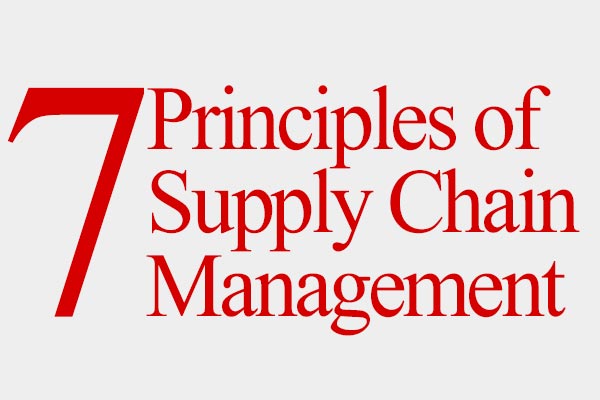There is scarcely anything that has not been covered in this amazing article, illustrating the brilliance of Anderson, Britt and Favre.
It’s a must-read for anyone associated with Supply Chain Management and certainly warrants archiving as a reference point to stimulate and refresh thinking in this regard.
Background
In 1997, Supply Chain Management Review published one article called “The Seven Principles of Supply Chain Management” written by David Anderson, Frank Britt and Donavon Favre.
At that time, Supply Chain Management (SCM) was a pretty new term so this article did the excellent job to explain important supply chain management principles in one shot.
More than 10 years pass and this article is considered the “classic” article and got republished in 2010, and again in 2013.
As of now, it got more than 160 citations from both scholarly articles and trade publications.
The following section will show the summary of 7 principles in infographic form and I will discuss if the concept from 1997 is still relevant to current business environment.
1) Adapt Supply Chain to Customer’s Needs
Both business people and supply chain professionals are trained to focus on customer’s needs. In order to understand customer better, we divide customers into different groups and we call it “segmentation”. The most primitive way to segment customer is ABC analysis that groups customer based on sales volume or profitability. Segmentation can also be done by product, industry and trade channel.
Back then, Anderson et al suggested that customer be segmented based on service needs, namely, “sales and merchandising needs” and “order fulfillment needs”.
I totally agree that we should focus on customer’s needs but this doesn’t seem to be enough these days. The reason is that your customers may not know what they need until your competitors offer something different.
For example, in 2011 Amazon initiated a program called Amazon Prime (free 2-day shipping and discounted 1-day shipping). Today, people are still discussing if this program makes sense.
But one thing for sure, customer turns to Amazon more and more. The morale of this story is that you should “anticipate” customer’s needs as well.
2) Customize Logistics Network
When you segment customer based on service needs, you may have to tailor different logistics networks to serve different segment. However, this principle doesn’t hold true for all situations.
For example, if you were contract manufacturer in China, you might already have different logistics networks for different customers. Each customer in US or EU might already control source of raw materials, ask you to provide dedicated production lines, nominate 3pl companies and air/sea carriers. So, logistics network design is kind of initiative driven mainly by customer.
3) Align Demand Planning Across Supply Chain
Supply chain practitioners are taught to share demand data with trading partners so nobody has to keep unnecessary stock. In general, this principle holds true. But in reality, only Walmart is actively sharing demand data to trading partners.
There is a very interesting paper by Williams and Waller 2011, the result of research found that;
- If you make demand forecast based on SKU/Customer level, using your own historical order data is more accurate than using POS data you get from retailers
- If you make demand forecast based on SKU/Store level, using POS data you get from retailers is more accurate than using your own historical order data
The implication is that the absence of demand sharing is not necessary bad. But when you got demand data from trading partners, you MUST use it the right way.
4) Differentiate Products Close to Customer
The is something that Dell is very famous for, keeping components and assemble them only after customer places the order in order to increase product variety. This principle is still true, but, there is another principle that you should consider.
“Standardization” is in the opposite polarity of “Differentiation”. For example, some cosmetics manufacturers formulate products and choose packaging and labelling that comply with regulations of multiple countries in Asia. So they only make one SKU that can be sold in 15 countries instead of 1 SKU/Country. By standardizing product appropriately, they can drive cost down drastically due to economy of scale. So standardization is something that you should also consider.
5) Outsource Strategically
This is the principle that stands the test of time. In short, don’t ever outsource your core competency. More information about outsourcing can be found from the infographic named “7 Pitfalls of Outsourcing and How to Avoid Them”.
6) Develop IT that Support Multi-Level Decision Making
If you search Google for the term “critical success factor erp”, you’ll find lots of information about how to implement Enterprise Resource Planning (ERP) successfully.
My opinion is that IT project shouldn’t be done in isolation, business process reengineering is something that you have to do before IT project. This will equip you with full understanding about process deficiencies then you can determine what kind of technology that you really need.
7) Adopt Both Service and Financial Metrics
Anderson et al suggested that activity based costing (ABC) be implemented so you can determine customer’s profitability. However, there is the interesting twist about ABC concept.
In 1987, Robert Kaplan and W Bruns defined the activity based costing concept in his book “Accounting and Management: A Field Study Perspective”. However, in 2003 Robert Kaplan said that it’s difficult to maintain ABC costing model to reflect changes in activities, processes, products and customers. Then, he introduced the refined concept called Time Driven Activity Based Costing.
To my understanding, practitioners are still using traditional ABC and supply chain researchers are still citing traditional ABC articles. My question is, does traditional ABC really work? Register, and comment below.
Editors Note: Original article posted on SupplyChainOpz

Article topics
Email Sign Up

















